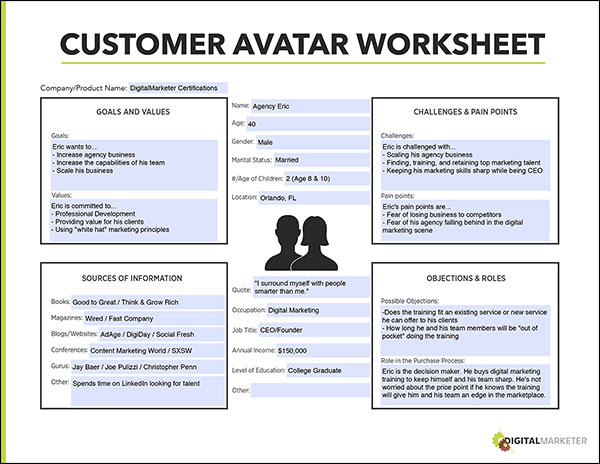Copy is one of the most important parts of your marketing strategy—but it’s also one of the most intimidating.
And with good reason. Writing copy can be REALLY hard. How should you know what to say in your email campaign that’s going to make someone decide to finally buy your product?
We have a solution for you. The type of solution that’s going to spell out exactly what to say when you want a reader to become a subscriber or a subscriber to become a customer.
Excited? So are we!
We’re going to show you how to write copy specifically based on your customer avatar. If you haven’t heard of it, we have a Customer Avatar Worksheet that helps you figure out exactly who your customers are.


This worksheet talks about their pain points, challenges, goals, values, and buying power. It even talks about what podcasts they listen to, what YouTube channels they’re watching, and what books are on their bookshelf. We get so specific that by the end of it you’re going to be able to tell us the name, age, and marital status of your ideal customer.
Why do you need to know THIS MUCH about your customers?
Because that’s how you figure out what you need to say to them to show you have the solution (aka product) they are looking for.
Let’s get into it!
Use Your Customers’ Pain Points and Challenges to Remind Them of What Happens if They Don’t Solve Their Problem
Every customer is just a person with a problem looking for a solution. That solution is your product and your copy is going to convey how well your product solves their problem. A lot of the time, businesses have great products—they just don’t know how to show their customer avatar the value of those products.
That’s where this copy comes in. Your customer avatar’s problem is causing them pain points and challenges. For example, at DigitalMarketer, we teach you how to be a great marketer. Our customer avatar’s pain point is that they’re struggling with their marketing efforts for their small business. Their challenge is that they don’t know where or how to improve.
We have courses and workshops to teach them how to become really, really good marketers.
That means that our copy is going to talk about how tough it is to market and not see the conversion and traffic you were hoping for (pain point), and not know how to improve (challenge).
Copy that converts talks about the pain point and challenges a customer is struggling through without your solution.
Let’s look at another example that you’ve probably seen a few hundred times in your life—a weight loss program. Customers of this program have the pain point that they want to lose weight and the challenge of not being able to stick to workout routines long enough to see a payoff. You’ve seen the copy on magazines or website ads saying, “Lose 20 pounds in one month and only workout ONCE a week!”
While we’ve been inundated by these types of advertisements for workouts, there’s a reason—they worked. Why? Because the copy pointed out the customer’s pain point (being 20 pounds overweight) and their challenge (not being able to stick to workout routines… working out only once a week is totally doable!).
See what’s going on here?
Talk About Their Goals and Values to Show Them the After State They’ll Experience Once They Have Your Solution
Your customers have goals that are bigger than just your product’s solution. For example, our business owner customers have a big goal of making more money for their company—marketing is just the turbo boost they’ll use to reach that goal. These goals go hand-in-hand with their values. For example, our business owner customers also value the experience of owning a successful company and the freedom that gives them.
This makes writing copy that motivates them to buy our products much easier. We can show them how our courses and workshops will help them make more money, help them attain that successful company vision, and feel like they’ve reached the ultimate entrepreneurial dream: freedom.
Every customer has goals and values. For example, an ecommerce trendy clothing company for women has customers who have a goal of being fashionable. Their customers value how they look and the feeling that it gives them. This ecommerce company can use their copy to talk about how owning certain products will help them achieve their goals and in turn, live their values.
Show Your Customers How Well You Know Them by Talking About the Books, Podcasts, Gurus, Etc. That They Look Up to
Who are you more likely to buy a product from, your best friend or a stranger on the street? If you said best friend, you’re with the majority. If you said stranger on the street, you’re the ultimate “Yes Woman/Man.” 😂
When you’re writing your copy, you want to talk about your customer’s pain points, challenges, goals, and values. You also want to show them how well you know them.
By referencing books that have impacted their lives, podcast episodes that were just published in your industry, or something that a guru that everyone looks up to is doing—you’re showing them how well you know them. You move past marketing to…”Wow, these people really get me.”
For example, a financial business blog could mention the Robinhood Snacks Daily podcast. They know their ideal reader is probably listening to this financial podcast every morning, so by referencing this specific podcast their readers are going to know that this blog gets them.
Or, let’s say that one of the biggest movers and shakers of your industry just published a book. You’d want to reference that book in your copy, showing how “in the know” your business is.
And just like that, you move from stranger on the street to (virtual) best friend.
Tell Them How to Get Your Solution Based Off of Their Buying Power
Every customer has different levels of buying power. For example, the ecommerce trendy clothing company’s customers have total buying power. Their customers are the one that are going to put their credit card information in and hit the purchase button.
But not every customer has the same level of power. For example, a marketer who wants to attend our annual Traffic & Conversion Summit might need to have their boss greenlight the purchase. In that case, you want your copy to show that you know they’ll need help with getting their boss to buy the ticket for you.
To do this, we create an email template that marketers can use to send their boss and show them why it would be valuable for them to come to the Traffic & Conversion Summit. In our drip email campaign, we’ll make sure to link out to that email template in our copy so that our customers know that we’re not leaving them high and dry wishing for a ticket. We’ve got them covered.
And that’s how you can use the Customer Avatar Worksheet to nail your copy by writing exactly what your customers need to hear.
Download the Customer Avatar Worksheet for free below so you can start writing conversion driving copy.














